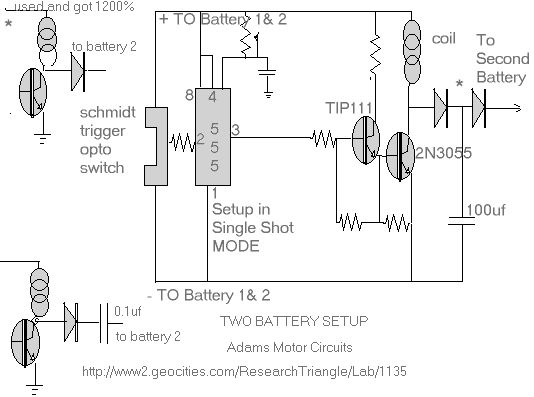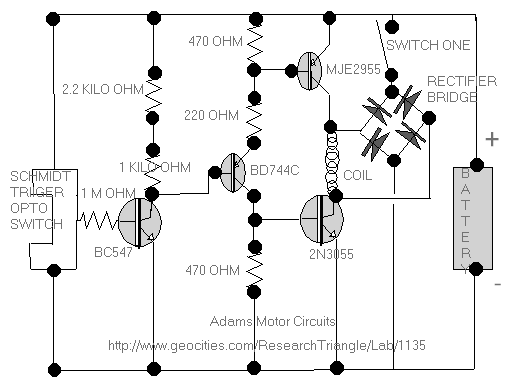
The Author of this article Michael Barrie Smith
The generator that I constructed was for my own curiosity it is made from a pulley off a V.N. Commodore. I have used Neodymium magnets.
The first attempt I used 10 x 20 x 3 mm magnet which fit snugly into the belt groove. The north and south poles are on the large flat areas only separated by 3mm I used 4 and 8 magnets with less than 100 % however it was very close.
The coils never got hot and it just kept on going I was using electronic switching and a opto schmidt trigger to detect slots cut into a piece of stiff card.
The transistor originally was getting hot so I modified the circuit to ensure faster switching times.
The battery was a 4 Ah lead acid battery the battery voltage only dropped 0.01 volts after 3 hours running. I changed the magnets to cylinder magnets 12mm dia x 25 mm.
I also changed the way the circuit charged this time. I used a second battery to test with. The circuit I was using would stop the generator at 11.80 volts.

The 4Ah was discharged to 12.40 volts. I now ran the generator without feedback from the 4Ah battery. After 30 min the battery had discharged to 11.80 volts.
The 60 Ah battery was now 12.40 volts this was not bad as the 60 Ah battery had a 0.6 Ah internal loss. Considering that both batteries have similar characteristics and are operated over the same voltage range it would look as though the is a net gain in energy.
However when I was looking at the traces on my scope this didn't seem so . I looks as if the energy gain is because of the manner of charging and not the device.
I believe that the battery which is a source of ions may be oscillating at it's resonant frequency causing a energy flow from vacuum fluctuations into the battery.
This would mean that the charge of the battery would be higher than the energy that was seen going into the battery.
This system didn't work with Capacitors instead of batteries and so I would assume that the ions gather the energy by organisation of the zero point fluctuations.
This is the same thing that ALL living animals use. ie the reorganisation of random energy.
I also tried to use laminated formers for a generator winding however the output voltage was too low for any use. I am currently chasing this up further.
I have set this up to prove to myself that it is possible to get energy from these types of devices. The next step is to use higher voltages as at this time I do not believe that I am causing pole folding which is where Robert Adams get his energy from.
This is because I am using very strong magnets. The use of weaker ferrite magnets may make pole folding possible at 12 Volts with 8 ohm windings.
The drive coils I used are 8 Ohms and are wound in .33 mm magnet wire. The former is a ex Telecom / Telstra : SLC/SLD/SLA/SLB ARK 521 vertical or horizontal relay. These can be obtained from Simms Metal in Townsville.
The stocks of these parts may not last long as the have just about pulled out all the old ARK equipment. At other locations around the country Simms Metal may have won the tender for recovered metal but I do not know.
The best duty cycle for this device is around 25% this can be achieved by dividing the optical disc into 22.5 degree segments at 90 degrees ie 4 x 22.5 degree slots.
The best firing angle seems to be when the magnet pole is 5 - 8 degrees past the drive coils. I believe that by using higher voltages on my unit I may do much better. The most efficient systems seems to be a two battery system as this separates the drive battery from the charge battery.
If a single battery is used it seems to lead to a less efficient result although this process should not to be discounted. Even at this stage if you imagine having a 4 KVA generator with the output of a 60 KVA generator . This is what we are looking at this stage. Not bad for impossible. The use of super magnets seems to hinder efficiency at low voltages.
Voltage and current must be high enough to fold the magnetic pole for greater efficiency. The type of magnet does not change the efficiency of the device at all once enough current is avalible to fold the poles.
Design seems to be the only thing that changes efficiency. Current, voltage, and layout all seem to determine efficiency. I believe that there may be two processes involved with the adams generator and if we can make both of these things happen together (same frequency)it will give dramatic results.
A hint to the battery process can be obtained from George Wiseman's capacitive battery charger design. With George's charger the pulsed D.C. current leads the voltage because of the series capacitor. This maybe the KEY to the first part of the puzzle.
I hope to have more information later this year. I hope this will help other researchers. It's not a stroll in the park to do this type of thing it takes many hours of pulling out ones hair. A accurate job makes performance better so take the time to get it right.

When winding your coils, wind them so that ELECTRON flow while the power is on comes the rear of the coil towards the poleface. After each layer run the winding back to the rear in a single turn and then start again. Do not just wind it.
This makes the coils a form of scalar winding and will improve the performance by inserting extra charge into the source when the field has collapsed.
The electrons will move under the the potential provided by the scalar electromagnetic field this device makes at resonance. I would like to hear what others have to say about this.
Michael Barrie Smith
P.O Box 492
Ingham
Queensland
Australia